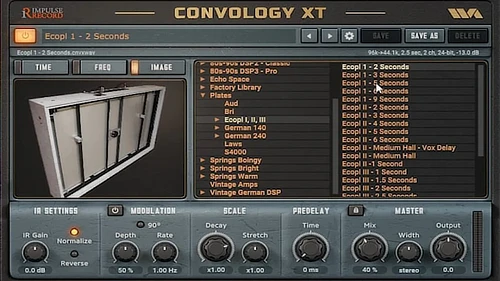As a musician, you must be prepared to perform in a wide variety of situations, and your equipment should be just as adaptable. That’s the philosophy behind the Ensoniq DP/4 Parallel Effects Processor, offering unparalleled flexibility, extensive programmability, and uncompromising sound quality.
To deliver this power, Ensoniq took inspiration from the concept of parallel processing, a technique from the computing world. The DP/4 features four discrete effects processors, labelled Units A, B, C, and D, each capable of generating 24-bit dynamic stereo effects. Importantly, each unit functions as a complete effects processor on its own, offering multi-effects capabilities with a vast range of parameters for precise control. However, with four processors working simultaneously, the Ensoniq DP/4 excels at creating complex, high-quality multi-effects without sacrificing fidelity.
The Ensoniq DP/4’s architecture offers a 4-input, 4-output system, enabling the processing of up to four separate signals at once. To maximise flexibility, the Ensoniq DP/4 includes a digital patch bay that allows you to route signals in either mono or stereo configurations, in series or parallel signal flows. This versatility means you can configure the DP/4 to suit any situation, from live performances to intricate studio sessions. The processor also features a built-in submixer to control signal output. With this submixer, you can preserve individual stereo images across the four outputs or consolidate multiple inputs into two outputs. There are over 30 signal routing options, ensuring that the DP/4 can handle even the most demanding configurations.
The Ensoniq DP/4 is a powerhouse of effects processing, offering a total of 46 algorithms. These include 43 single-unit stereo effects and 3 multi-unit effects algorithms. From rich, world-class reverbs that recreate spaces ranging from intimate rooms to grand halls, to precise 6.6-second delays (syncable to MIDI clock or Tap Tempo), the DP/4 excels at delivering professional sound. Modulation effects include lush choruses, flangers, phasers, and tremolos, while the rotating speaker algorithm authentically replicates the sound of a Leslie cabinet. Guitarists will appreciate the inclusion of amp and speaker simulations as well as the dynamic VCF-Distortion algorithm for expressive wah-wah effects. Additionally, the built-in LFO enables effects like vibrato, panning, and tremolo, while a sine/noise generator allows for the creation of sound effects even without an instrument input.
For audio professionals, the Ensoniq DP/4 includes powerful tools such as four pitch shifters, a parametric EQ, shelving EQ, expanders, ducking, gating, and a fast-responding compressor. These features make it ideal for recording, live broadcast, video production, or post-production workflows.
Each of the Ensoniq DP/4’s 46 algorithms can be modulated in real time by any two of 138 MIDI or analogue controllers, offering dynamic control over effects and allowing for expressive performances. With MIDI Program Changes, you can seamlessly recall presets or reconfigure the routing of the DP/4, enabling full automation – ideal for live performances or studio integration.
The Ensoniq DP/4 includes 400 presets to get you started, with configurations suited to a variety of workflows. Presets are organised into four categories:
- 1-Unit Presets: Single-processor effects
- 2-Unit Presets: Two combined effects processors
- 4-Unit Presets: Full four-unit configurations
- Config Presets: Global settings that store the full DP/4 configuration
Each category includes 100 memory locations (50 ROM and 50 RAM), giving you extensive options for immediate use or custom programming. The DP/4 supports four primary configuration types:
- 4 Source Config: Four independent signals using four 1-Unit presets.
- 2 Source Config: Two signals using two 2-Unit presets.
- 1 Source Config: A single signal processed with one 4-Unit preset.
- 3 Source Config: A flexible mix of 1- and 2-Unit presets.
These configurations ensure you can adapt the DP/4 to any signal routing requirement, whether for multi-instrument performance or complex studio applications.
User-friendly design is a key feature of the DP/4. Dedicated input and output knobs for each of the four channels allow for instant level control, with signal and peak LEDs to help optimise gain structure. Each processor has a dedicated button for quick selection, preset loading, editing, or bypassing. The large Data Entry Knob makes parameter adjustments effortless, while the Compare button allows you to toggle between your current edits and the stored settings.
A 32-character backlit display provides clear and accessible information, including selected algorithms, parameters, and presets. For critical studio applications, it also functions as a gain reduction meter when using compression. An additional 2-character LED provides real-time parameter values during editing and confirms MIDI activity, ensuring smooth integration into MIDI-based setups.
The Ensoniq DP/4 set a new standard in effects processing, combining flexibility, programmability, and pristine audio quality. Its revolutionary design offered musicians and producers a compact yet powerful tool, capable of handling even the most demanding live or studio scenarios. The success of the DP/4 led to the release of the Ensoniq DP/4+, an improved version that built upon its predecessor’s legacy.
With its ability to route, process, and modulate effects in countless ways, the DP/4 remains a celebrated piece of audio gear, synonymous with versatility and professional-grade sound. Whether you need world-class reverbs, dynamic modulation effects, or intricate signal processing tools, the DP/4 delivers it all in a single, cohesive unit.













